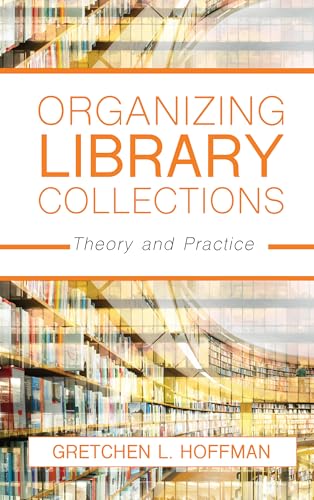Items related to Organizing Library Collections: Theory and Practice

Synopsis
Libraries organize their collections to help library users find what they need. Organizing library collections may seem like a straightforward and streamlined process, but it can be quite complex, and there is a large body of theory and practice that shape and support this work. Learning about the organization of library collections can be challenging. Libraries have a long history of organizing their collections, there are many principles, models, standards, and tools used to organize collections, and theory and practice are changing constantly.
Written for beginning library science students, Organizing Library Collections: Theory and Practice introduces the theory and practice of organizing library collections in a clear, straightforward, and understandable way. It explains why and how libraries organize their collections, and how theory and practice work together to help library users. It introduces basic cataloging and metadata theory, describes and evaluates the major cataloging and metadata standards and tools used to organize library collections, and explains, in general, how all libraries organize their collections in practice. Yet, this book not only introduces theory and practice in general, it introduces students to a wide range of topics involved in organizing library collections. This book explores how academic, public, school, and special libraries typically organize their collections and why. It also discusses standardization and explains how cataloging and metadata standards and policies are developed. Ethical issues also are explored and ethical decision-making is addressed. In addition, several discussion questions and class activities reinforce concepts introduced in each chapter. Students should walk away from this book understanding why and how libraries organize their collections.
"synopsis" may belong to another edition of this title.
About the Author
Gretchen Hoffman is an Associate Professor in the School of Library and Information Studies at Texas Woman’s University. She has been teaching there since 2007. Her teaching and research agenda centers on the organization of information, specifically library cataloging. Courses she teaches include Cataloging and Classification, Advanced Cataloging and Classification, Collection Development, and Information Organization.
Before moving to Texas Woman’s University, Hoffman was a professional cataloger at the University of Kansas, specializing in complex and difficult cataloging, music cataloging (scores and audio recordings), and cataloging German-language monographs. Prior to that, she worked as a professional serials cataloger at Portland State University, specializing in federal government documents.
"About this title" may belong to another edition of this title.
US$ 2.64 shipping within U.S.A.
Destination, rates & speedsSearch results for Organizing Library Collections: Theory and Practice
Organizing Library Collections : Theory and Practice
Seller: GreatBookPrices, Columbia, MD, U.S.A.
Condition: good. May show signs of wear, highlighting, writing, and previous use. This item may be a former library book with typical markings. No guarantee on products that contain supplements Your satisfaction is 100% guaranteed. Twenty-five year bookseller with shipments to over fifty million happy customers. Seller Inventory # 35360997-5
Quantity: 1 available
Organizing Library Collections: Theory and Practice
Seller: Textbooks_Source, Columbia, MO, U.S.A.
Hardcover. Condition: Good. Illustrated. Ships in a BOX from Central Missouri! May not include working access code. Will not include dust jacket. Has used sticker(s) and some writing or highlighting. UPS shipping for most packages, (Priority Mail for AK/HI/APO/PO Boxes). Seller Inventory # 005053580U
Quantity: 1 available
Organizing Library Collections : Theory and Practice
Seller: GreatBookPrices, Columbia, MD, U.S.A.
Condition: New. Seller Inventory # 35360997-n
Quantity: 1 available
Organizing Library Collections
Seller: PBShop.store US, Wood Dale, IL, U.S.A.
HRD. Condition: New. New Book. Shipped from UK. Established seller since 2000. Seller Inventory # CW-9781538108505
Quantity: 15 available
Organizing Library Collections
Seller: PBShop.store UK, Fairford, GLOS, United Kingdom
HRD. Condition: New. New Book. Shipped from UK. Established seller since 2000. Seller Inventory # CW-9781538108505
Quantity: 15 available
Organizing Library Collections : Theory and Practice
Seller: GreatBookPrices, Columbia, MD, U.S.A.
Condition: As New. Unread book in perfect condition. Seller Inventory # 35360997
Quantity: 1 available
Organizing Library Collections : Theory and Practice
Seller: GreatBookPricesUK, Woodford Green, United Kingdom
Condition: New. Seller Inventory # 35360997-n
Quantity: 1 available
Organizing Library Collections: Theory and Practice
Seller: Ria Christie Collections, Uxbridge, United Kingdom
Condition: New. In. Seller Inventory # ria9781538108505_new
Quantity: Over 20 available
Organizing Library Collections : Theory and Practice
Seller: GreatBookPricesUK, Woodford Green, United Kingdom
Condition: As New. Unread book in perfect condition. Seller Inventory # 35360997
Quantity: 1 available
Organizing Library Collections: Theory and Practice
Seller: California Books, Miami, FL, U.S.A.
Condition: New. Seller Inventory # I-9781538108505
Quantity: Over 20 available

